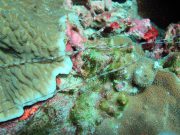Diving with Spaghetti Worms
Lanta Marine Life | Terebellidae
Spaghetti worms are a marine relative of the earthworm, growing up to 15 cm in length. They have long, cylindrical bodies that are divided into many similar sections called segments. Some structures, like muscles, kidneys, and nerves are repeated in each segment. These worms are resident at all of the dive sites around Koh Lanta.
Body segments have appendages on each side which have small bristles protruding. They have many long tentacles radiating from the head, close to the mouth, which are used for finding and collecting food. Tentacles may be up to 1 m long (100 cm).
Spaghetti worm tentacles are grooved and lined with hair-like cilia that help collect and transport food to the mouth. Food that drop on the tentacles are carried down the groove and to the hidden mouth. Larger food particles are lassoed by the elastic tentacles and dragged to the mouth.
The elastic tentacles can be withdrawn if necessary and can regenerate if broken or eaten by predators. Some species of butterflyfish eat spaghetti worm tentacles.
Most spaghetti worms live in burrows or crevices and construct tubes for themselves from sand and gravel which they cement together with a mucus-like secretion from a gland close to the mouth.
Spaghetti worms generally do not leave their tube or reef crevices and are considered sedentary worms. The use their bristles to move up and down inside their tube.
1 species found on this page:
Banded Spaghetti Worm
(Lanice conchilega)

Banded Spaghetti Worm @ Koh Haa
The Banded Spaghetti Worm grows to around 15 cm and has long, light and dark banded feeding tentacles which are connected around the mouth.
The tentacles can reach over 1 m in length and are extended to collect food. If disturbed, the tentacles can coil and retract.
The Banded Spaghetti Worm is prayed upon by large cone shells.
Diving with Spaghetti Worms around Koh Lanta
Scuba Diving & Snorkel Trips
If you'd love a chance to spot Spaghetti Worms on one of our daily high season diving trips from Koh Lanta then send us an email to info@diveandrelax.com.
Join our high season speedboat dive trips to some of Thailand's best dive sites and enjoy small groups, short journey times, with a focus on great personal service, safety and fun.
Not yet a certified diver? Learn to Scuba Dive on Koh Lanta with the 3 day SSI Open Water Diver course.
Book online to save 10% on dive trips and scuba courses on Koh Lanta.
Find Out More
Indo-Pacific Marine Life Guides
- Allen, G., Steene, R., Humann, P., DeLoach, N. (2003) Reef Fish Identification, Tropical Pacific. Jacksonville, FL., USA: New World Publications, Inc., ISBN 1-878348-36-1.
- Humann, P., DeLoach, N., (2010) Reef Creature Identification, Tropical Pacific. Jacksonville, FL., USA: New World Publications Inc., ISBN 978-1-878348-44-9
- Debelius, H. (2013) Indian Ocean Reef Guide. Frankfurt, Germany: IKAN - Unterwasserarchiv, ISBN 978-3-939767-52-7.
- Debelius, H. (2004) Nudibranchs and Sea Snails, Indo-Pacific Field Guide. Frankfurt, Germany: IKAN - Unterwasserarchiv, ISBN 3-925919-51-1
- Erhardt, H., Knop, D. (2015) Corals Indo-Pacific Field Guide. Frankfurt, Germany: IKAN - Unterwasserarchiv, ISBN 3-925919-69-4.
- Veron J.E.N., Stafford-Smith M.G., Turak E. and DeVantier L.M. (2016). Corals of the World
